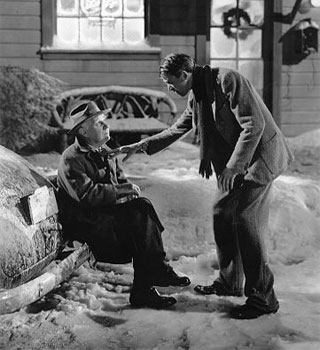Paging Clarence Oddbody
By J. Thomas Duffy
Phil Leigh writes a great newsletter, and blog, 'Inside Digital Media', and, last week, he posted a piece, on being pro e-book, illustrating it with what has become a very popular holiday tale;

A Christmas Lesson for Publishers

Over on Zoetrope's All Story site, ''The Great Gift' in it's entirety;
Here's the intro;
We highly recommended you sign-up for the daily email from 'Inside Digital Media'.
And, remember, as Clarence Oddbody inscribed in the book (The Adventures of Tom Sawyer) he left for George Bailey, that is solid, not just at Christmas, but all-year round;
"No man is a failure who has friends."

(Cross Posted at The Garlic)
Phil Leigh writes a great newsletter, and blog, 'Inside Digital Media', and, last week, he posted a piece, on being pro e-book, illustrating it with what has become a very popular holiday tale;

A Christmas Lesson for Publishers
One February night in 1938 Philip Van Doren Stern had a dream. The 38 year-old published historian also had a deep interest in fantasy and the macabre. As with most dreams his morning recollections were vague and conflicting. It had something to do with a man who had never been born, or wished he had never been born.
Stern decided to write down his recollections. A narrative began to take shape and with later revisions became a short story he titled The Greatest Gift. It was a simple celebration of things taken for granted.
Regrettably he failed to interest a publisher over the next four years. Consequently, toward the end of 1943 Stern printed two hundred copies at his expense and enclosed one in each Christmas card envelope. One recipient was a Hollywood agent who asked if she might show it to some studios. Surprisingly, RKO bought the film rights for $10,000 in the spring of 1944. By December, Good Housekeeping finally published the story.
Hollywood screenwriters set to work on the manuscript until the essence of Stern’s story shrank into the Third Act. Eventually it would pass through nine writers, including Dorothy Parker and Frank Capra after Capra purchased RKO’s rights for $50,000.
The movie was finally released in 1946 but fell modestly short of break-even on its first run. It rose to 26th place in 1947 box office receipts. Although nominated for five Oscars it failed to win any. Thereafter the rights passed through a series of owners ending-up at Viacom.
During the 1980s local TV stations began to run it during the Christmas season. They regarded it as opportune low cost programming for time slots not allocated to the network shows. In 1984 an aged Frank Capra commented that the rise in popularity “was the damnedest thing I’ve ever seen”. He felt like “the parent of the kid who grows up to be President – but it’s the kid who did the work. (He) didn’t think of (the child) that way.”
By 1998 the American Film Institute ranked It’s a Wonderful Life as the 11th best movie of all time and rated George Bailey as the 9th most popular hero.

Over on Zoetrope's All Story site, ''The Great Gift' in it's entirety;
Here's the intro;
Unable to find a publisher for "The Greatest Gift," Philip Van Doren Stern printed two hundred copies of the story and used them as Christmas cards in 1943. From this humble beginning, a classic was born. Van Doren Stern's story captivated Frank Capra, who said he "had been looking for [it] all [his] life." Capra's beloved adaptation, It's a Wonderful Life, starring James Stewart, Donna Reed, and Lionel Barrymore, was released in 1946, and while the film, which received Academy Award nominations for Best Picture, Best Actor, and Best Director, didn't take home an Oscar, it has secured its place in the American holiday tradition.
We highly recommended you sign-up for the daily email from 'Inside Digital Media'.
And, remember, as Clarence Oddbody inscribed in the book (The Adventures of Tom Sawyer) he left for George Bailey, that is solid, not just at Christmas, but all-year round;
"No man is a failure who has friends."

(Cross Posted at The Garlic)



0 Comments:
Post a Comment
<< Home